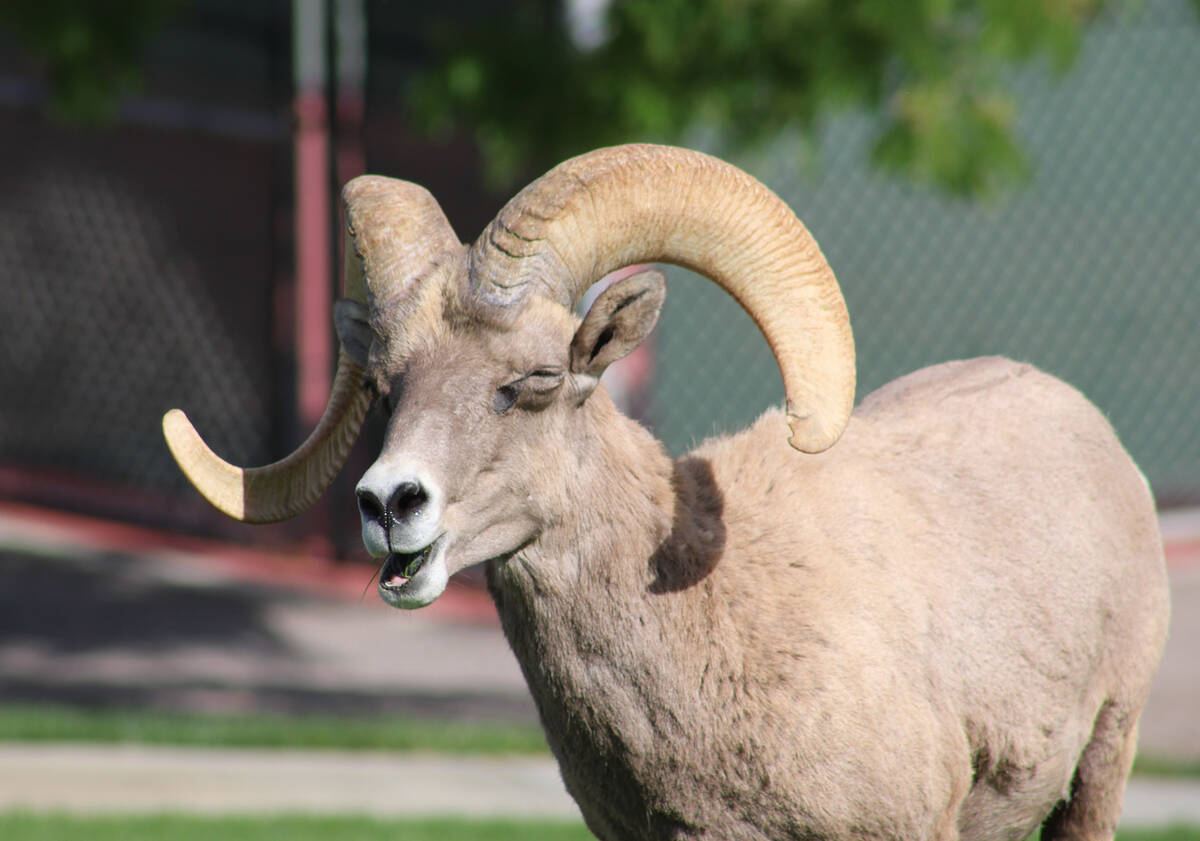A look at Hemenway Park’s popular visitors
They’ve become Boulder City’s unofficial mascot, as well as a tourist attraction for many visitors.
The bighorn sheep at Hemenway Park have been a mainstay for many years as they can often be seen enjoying the cool, wet grass. But according to Lauren MacLeod, wildlife education coordinator for the Nevada Department of Wildlife, their presence is no coincidence.
“Desert wildlife is well-adapted to the harsh, dry climate that we face in the Mojave,” she said. “They are equipped to handle the extremes, but if they have an opportunity for easier food, water, and shelter, they’re going to take advantage.”
The green, lush forage at Hemenway Park is a huge attractant for sheep in the area.
“There is a surprising amount of forbs intermixed with the grass for a well-rounded food source, and the sprinklers make for an easy water source,” MacLeod said. “Tall trees throughout the park provide shelter and shade from the elements – a sharp contrast from the open desert scrub in the surrounding landscape.”
The NDOW hosted a question-and-answer session at the park Sunday and have two additional informational meetings set for June 11 and June 25 from 9 a.m. to 12 p.m.
During drought years, she said some sheep will visit year-round. However, sheep would rather be on the mountain where they have steep terrain and space from humans, who are naturally classified as a predatory threat to sheep.
Those at Hemenway Park are normally there about half the year when forage conditions are less than desirable on the adjacent mountain.
“This overlaps with the hot summer months when the easy access to water and shade at the park provides an added bonus,” she said. “Also, studies show that ewes like to find really steep terrain to have their lambs. These ewes go off by themselves in the December/January time-frame, and then when the lamb is old and mobile enough, the ewe changes her selection strategy to focus on high-quality forage during the lactation period. Lambs normally wean at about four months old.”
The River Mountain bighorn population has contracted since at least 2015 with the inception of disease, she said. The disease is bacterial pneumonia that originated from wild sheep and domestic sheep interactions. However, in Nevada most of the transmission occurs from wild sheep to wild sheep. The population estimate in 2015 was almost 300 sheep, but today it is around 180.
“As you can imagine, it used to be more common to see around 100 sheep visiting the park, but now the maximum is closer to 50 or 60 sheep,” MacLeod said.
Jamie Curreri, the city’s public works director, said that the bighorn sheep normally just eat grass and then leave but that, “unfortunately, like most wild animals, they do leave droppings in the park. So, when visiting, be sure to check the bottom of your shoes before you get into your car.”
When city crews are at the park doing maintenance or mowing the lawn and the sheep are present, Curreri said they try and respect their space and that often, the sheep find another area to graze while city crews are doing their work. As for the general public, he said they occasionally get calls from residents reporting the bighorn sheep had been in their yard.
“But most people embrace life near the herd,” Curreri said. “Because they are wild animals, we refer calls to the Nevada Department of Wildlife.”
Like the city, MacLeod said her department receives occasional phone calls from nearby residents regarding damage. Most of this damage is sheep foraging on easily accessible, unfenced gardens.
“Choosing a home based on a beautiful natural landscape with abundant wildlife viewing opportunities means that sometimes that wildlife is going to find us in our own backyard,” she said. “Learning more about the wildlife that call your neighborhood home is key to learning how you can live alongside them.”
Despite the sheep being the city’s unofficial mascot, MacLeod was quick to remind everyone that they are not to be treated like pets, despite being used to being around humans. The sheep that visit Hemenway Park have become relatively habituated to humans.
“Frequent exposure to a natural predator that continues to pose little to no threat has essentially ‘trained’ the sheep to become less reactive to sharing the same space as humans,” she said. “That said, they are still wild animals and although are typically harmless, a ram during the rut time-frame (July and August) can have unpredictable behavior.
A more direct concern pertaining to the sheep, she said, is disease transmission among adjacent sheep populations due to the easy movement to the southern ranges. The busy Boulder City Parkway adjacent to the park also creates a higher potential for sheep being hit by vehicles.
When residents or visitors are in the park during the same time as the sheep, MacLeod said people should give them their space by viewing them from a distance with the use of binoculars or a camera zoom lens.
“Despite the sheep having a seemingly calm demeanor, they are still wild animals and we are still a natural threat to their safety,” she said. “If they are showing nervous body language, it is especially important to give them their space, not only to keep ourselves safe, but to keep the stress levels down of the sheep.”
Something else MacLeod stressed was that the bighorn sheep should not be fed, under any circumstances. That’s because they are perfectly capable of foraging for food on their own. Their digestive system, she said, is built for a specific diet, so an introduction of food that is unnatural or out of season to their typical desert forage can be dangerous for them.
“Food conditioning for any wild animal can lead to aggressive behavior as well,” she said. “On that note, if you are pulling over on the road to feed them, or any wild animal, you are providing them with a death wish. If they associate the road with food, it is only a matter of time before they get hit by a car.”
Ron Eland is editor of the Boulder City Review. He can be reached at reland@bouldercityreview.com or at 702-586-9523.


















